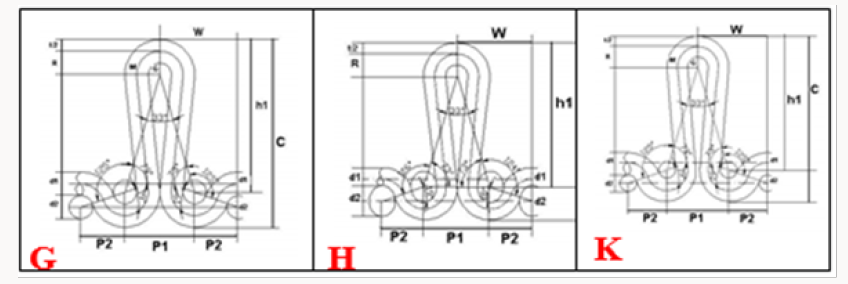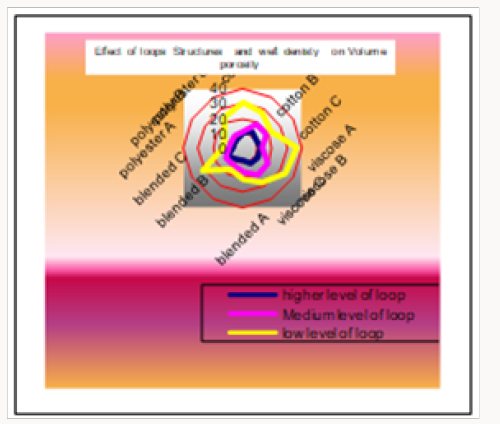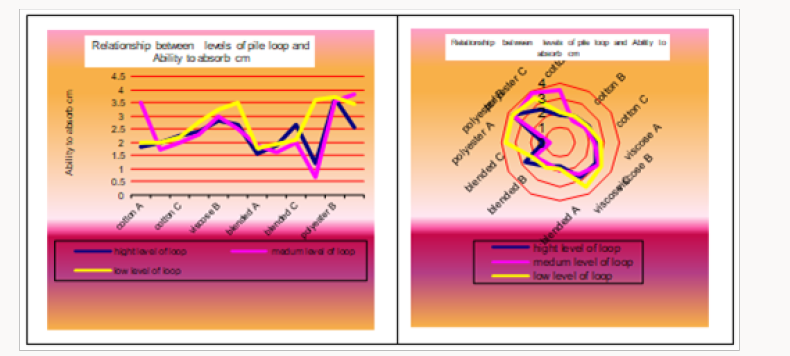
Lupine Publishers Group
Lupine Publishers
Menu
ISSN: 2637-4595
Review Article(ISSN: 2637-4595) 
Volume Wicking and Wetting in Terry Woven Fabrics Volume 2 - Issue 1
Elnashar Elsayed1* and Albu Adina-Victoria2
- 1Kaferelsheikh University, Egypt
- 2Faculty of Energy Engineering and Industrial Management, Department of Textiles, Leather and Industrial Management, University of Oradea, Romania
Received: April 13, 2018; Published: April 23, 2018
*Corresponding author:Elnashar Elsayed, Kaferelsheikh University, El-Geish Street, Egypt
DOI: 10.32474/LTTFD.2018.02.000127
Abstract
The proposed model of predictions of volume wicking and wetting in 3D terry woven fabrics is based on the simplified description of the thread of terry structure, and it works with the woven fabrics description of loops thread structure. The following terry woven fabrics parameters are used in the model: woven structures, fineness of fibers, and number of fibers at the cross-section in the warps (loop, ground) and the filling. The formation of loops levels and the liquid in the longitudinal textile is described in detail, and particular phenomena are discussed. Important parameters are used in the model of wicking, limit and their performance, and facilitate evaluation of a three-dimensional plain pile warp woven fabrics. Simulation results provide information of liquid volume wicking and wetting into terry woven fabrics assemblies as a function of time. The work focuses mainly on the relationship between fiber orientation and the liquid wicking and wetting rate, the results are potential volume porosity theory in agreement with known experimental evidence. The parameters with very small influence in usual threads are disregarded. The proposed wicking and wetting model allows a functional dependence of suction height on the parameters of the fiber bundle to be expressed in analytical form.
Keywords: Terry; Wetting; Wicking; Potential; Volume; Porosity
Introduction
Wetting is a fundamental phenomenon that takes place at the first moments when fabrics come into touch with liquid. Wetting is characterized by the displacement of fiber-vapor interface to fiber liquid interface. Wet ability studies usually involve the measurement of contact angles as the primary data, which indicates the degree of wetting when a solid and liquid interact [1]. The wet ability of fibrous assembly is affected by the chemical nature of fiber surface, the fiber geometry and the surface roughness [2]. Wetting phenomena has been carried out by liquid and air interface with textile materials. Basically wetting is physical interaction of fabric with liquid, air and their surface energies results into wicking [3, 5]. Wicking is unconstrained liquid movement, driven by capillarity’s. Capillarity deals with the penetration ability of liquid into fine pores of fibre to travel along its walls. Wetting, wicking and capillarity are influential parameters to relate the fluid transport in textile fibrous media in the fiber is replaced by a solid-liquid interface and this phenomenon is called ‘wetting’ [1]. Wicking is a strip of porous material up which liquid fuel is drawn by capillary action loop in terry woven fabrics throws involved place of porosity, as absorb or draw off (liquid) by capillary action of relating to capillaries or capillarity. Any of the fine branching loops vessels that form a network between the round warp as arterioles and weft as venules. A tube that has an internal diameter of dinisties thinness, the behaviour of a given textile during its contact with water is one of the important properties of textiles. Wicking makes it possible to use textiles for a series of other special applications: wicks for candles and lamps with oil, or some modern flameproof finishing’s for housing textiles. Which wicks liquid through the pile plane with minimum wicking-up in the pile warp of the fabric, is designed as a tree-levels structure [3, 5].
Experimental Work
Constructed according to the setting theory, the used are carded warp yarns of 50 Tex for warp pile, 50 Tex for ground warp, was spun from 100% cotton staple fiber and weft variables on three levels group of pile fabrics structure, the values for maximum leaner densities, setting thread density; a group of samples made weft from polyester, fibran, viscose, blended (cotton/polyester), and cotton. The pile warp woven fabrics samples are the fabrics designed formation technique and produced on the Picanol weaving machine attachment with head of jacquard in Eldelta spinning and weaving, Egypt, and fabrics tested in consolidation fund at Alexandria, Faculty of Science, Tanta University, Faculty of Engineering Elmansura, and Kaferelshikh University, Fabric specification: (warp threads: Loop and ground of cotton Leaner density is 50 Tex, and density/cm 11 threads). (Wefts: cotton Leaner density is 37.5 Tex, viscose 40 Tex, blended 25 Tex, polyester 17 Tex,). Used plain weave denting in one gate: 1 pile warp yarns in first face, 1 pile warp yarns in second face, 2 ground yarns. Permeability testing under laboratory conditions the air permeability is standard evaluated according to A.S.T.M. standards [4-6].
Result and Discussion
We suggest Potential Volume Porosity theory (PVP): includes partly a therid dimension structure of pores, are based on idea that wetting flows around of yarns not only in a perpendicular direction in yarns of loop and background (warp-weft) the following equation (1). Here, the first factor represents. Then, volume porosity is given by these sample symbols:
Description for equation: Where: PVP = Potential volume porosity, TTK = thickness of warp pile woven fabrics. TPI; TG; yarn count of pile and ground warp in Tex system. Ty; Yarn count of weft in Tex system. A PI; a G; crimp for pile and ground warp, ay; crimp for weft. PPI; PG; density of yarns/cm for pile warp and ground warp Py; density of yarns/cm for weft. γ PI; γ G; scientific density for pile and ground warp spun fibers. γ y; scientific density for weft spun fibers. dPIB; vertical cross section for yarn warp. dGB; Vertical cross section for pile and ground warp. dyB; vertical cross section for yarn weft. dPIr; dGr; horizontal cross section for pile and ground warp. dyr; horizontal cross section for weft yarn. LPIo; LGR; length yarn of pile and ground warp extended between tow intersections in perfect repeat of woven construction. LyR; Length of weft yarn extended between tow intersections in perfect repeat of woven construction. LPIo; LRG; width repeat of pile and ground warp. ; Number of piles in cm. LRy; width of repeat of weft. RPIo; RG; number of yarn repeats for pile and ground warp. Ry; number of yarn repeats for weft. aPIo; aG; crimp for pile and ground warp. ay; crimp for weft. PPI; PG; density of yarns/cm of pile and ground warp. Py; density of yarns/cm of weft and IFC=1.So, γ: Scientific density for cotton (1.54)-viscose (1.46)-polyester (1.38).-Fibran (1.52) and the blended (cotton/polyester (50/50) (1.46) the length of yarn (ground warp-weft) in equation (4A, B), first the length of warp extend between two intersection in perfect repeat of woven construction (LGR). potential volume porosity theory investigated the mechanics of pile woven fabrics structures using force geometrical and physical principles to assume the loop shape function. Basic parameters of a pile woven fabric are: loop width Ωr , loop height Δr , loop length ℓpi,
Where ℓ is loop length [mm], Ωr is loop width [mm], Δr is loop height [mm]
Where: p1, space between wefts of loop fasted, P: Widths repeat. And d p i : is pile yarn thickness [mm]. The loop length is influenced by the yarn input tension, pile woven fabric take-down tension, pile woven velocity, materials friction in the pile woven zone, yarn structure and properties, yarn linear density, etc. The pile woven fabric vertical density W: is defined by the pile woven density and the yarn input tension; it changes only slightly with the change of the yarn input tension for conventional yarns for elasticized. The structural parameters of a warp pile woven fabrics fabric are: the head of loop-spacing (P): Widths repeat, the pile woven fabric vertical density (w) and the thickness of the pile yarn (d p i ). The rest of the geometrical parameters required for the complete description of the structure derive analytically from them. The estimation of the geometrical parameters has been based on the assumption of the ideal cotton yarn of towel fabrics based on the assumption of the ideal cotton yarn of towel fabrics (Figure 1).
Thus the yarns are represented as homogenous cylinders of constant diameter for pile and ground, with initial restricted contact area between them. We consider initially the independent parameters c, W, d1=d2= d i p , P2, P1, P, and in addition the: distance t as it is noticed in Fig. 1 Geometrical model of Low level of warp pile woven fabrics structure (Figure 2, 3).
Calculation of terry loop length (L)
Due to the symmetry of the unit cell the length of the warp pile loop is received by the equation12. Yarn crimp ratio cross-section change is not neglected it may be assumed, that greater angel of contact will be connected with more important change of yarn cross-section from circular into approximately elliptical.
Due to the symmetry of the unit cell the length of the pile is received by the equation (6).
Where: Mass density, ρ, ΔV →0 , The density of hydraulic fluids normally lies between 0.85 and 0.91 kg/dm3, p1, space between wefts of loop fasted, P: Widths repeat. And d i p : is pile yarn thickness [mm]. The loop length is influenced by the yarn input tension
Where: Vb E Volume bulk modulus of the liquid, VG0 volume of gas entrained in the liquid at atmospheric pressure, VL0 volume of the liquid at atmospheric pressure, p0 atmospheric pressure 0 ( p = 1 bar) , p liquid pressure, and K volume bulk exponent (K = 1.4).
Evaluation of the Geometrical Model
Potential volume porosity theory(PVP) for detection of geometric characteristics of structure of the warp pileabric of cotton, polyester, viscose rayon, blended (polyester/cotton), for weft and the warp of cotton as volume bulk modulus of the liquid based initially on the comparison of the experimentally defined warp pile loop length of a given fabric to the respective calculated by the geometrical model for the same main parameters (c, w, D ) which are characterized by their constructional parameters as are set of warp and weft yarns, diameters or fineness of warp and weft yarns and by the plain of weave. On the base of the area covering value is chosen suitable model for description of woven fabric structure (Figure 4).
Wiks-up liquid through piles
Potential volume porosity theory apparently from the (Figure 5) that the specific volume of the Wiks-up in lower level of piles are highest value than the medium and higher level which used cotton and even the cotton maximum density of weft, in addition to the viscose rayon are maximum holding water behavior is higher than the pure cotton maximum holding water. This behavior indicates that the filling spaces in between fiber-to-fiber and yarn-to-yarn in the fabric, construction is decreasing by water filling up. The second level of pile, which wicks liquid through the pile plane with minimum wicking-up in the pile warp of the fabric, is designed as a tree-levels structure. The top and bottom piles are designed by three different densities (15, 18, and 21) of weft in fabrics. These three levels of density are used as substrates in flocking. These channels of pile are designed to promote the flow through the plane of the fabric, these samples are tested to observe how much of the liquid dropped is transferred to the bottom piles by measuring the distance the liquid travels in the top and bottom piles. The results of these tests will be used to model wicking in these structures. Higher level of pile are highest value than the medium and lower levels, this behavior indicates that the filling density and interlacing, the specific volume is significantly influenced by loop length. For the second level of piles, the diagram will be setup to predict the effects of the Tex count of the flock fibers and the flock density. In this diagram, it will be assumed that in fabric of higher level, the middle level, which consists of parallel-laid staple filaments, and in fabric of medium level, the middle level of pile that consists of the flocked fibers.
Conclusion
The presented approach allows taking into account the stacking and forming both in flow and structural analysis. In a case of flow analysis this allows accurate study of the effect of pilelength reinforcement structure (nesting deformation etc.) on the permeability. For numerical analysis of flow through reinforcement the El Nashar model of potential volume porosity theory (PVP) has been chosen to calculate porosity is based on idea that air flows around of yarns not only in a perpendicular direction.
References
- E Kissa (1996) Wetting and Wicking, Textile Research Journal 66(10): 660-668.
- A M Cazabat, M A C Stuart (1986) Dynamics of wetting: “Effects of surface roughness”, The Journal of Physical Chemistry 90(22): 5845- 5849.
- EAEL Nashar (2008) “Representative volume of design elements and mathematical of pile woven fabrics”. International Workshop “Physics of Fibrous Materials: Structure, Properties, Science Intensive Technologies and Materials” (SMARTEX-2008) that take place in the Ivanovo State Textile Academy (Russia) 26-27.
- ASTM (1981) Annual Book, ‘Standards, Textiles-Yarn-Fabric General Test Methods’-part, 22” D1777-64, ASTM.D 737- 5030.”
- EA ELNashar [2005] “Volume Porosity and Permeability in Warp Pile Woven Fabrics” 2nd International Conference of Textile Research Division NRC, Cairo, Egypt 11-13.
- EA ELNashar [2005] “Volume Porosity and Permeability in Multi-Layer Woven Fabrics” Autex Research journal, Poland.

Top Editors
-

Mark E Smith
Bio chemistry
University of Texas Medical Branch, USA -

Lawrence A Presley
Department of Criminal Justice
Liberty University, USA -

Thomas W Miller
Department of Psychiatry
University of Kentucky, USA -

Gjumrakch Aliev
Department of Medicine
Gally International Biomedical Research & Consulting LLC, USA -

Christopher Bryant
Department of Urbanisation and Agricultural
Montreal university, USA -

Robert William Frare
Oral & Maxillofacial Pathology
New York University, USA -

Rudolph Modesto Navari
Gastroenterology and Hepatology
University of Alabama, UK -

Andrew Hague
Department of Medicine
Universities of Bradford, UK -

George Gregory Buttigieg
Maltese College of Obstetrics and Gynaecology, Europe -

Chen-Hsiung Yeh
Oncology
Circulogene Theranostics, England -
.png)
Emilio Bucio-Carrillo
Radiation Chemistry
National University of Mexico, USA -
.jpg)
Casey J Grenier
Analytical Chemistry
Wentworth Institute of Technology, USA -
Hany Atalah
Minimally Invasive Surgery
Mercer University school of Medicine, USA -

Abu-Hussein Muhamad
Pediatric Dentistry
University of Athens , Greece

The annual scholar awards from Lupine Publishers honor a selected number Read More...


















